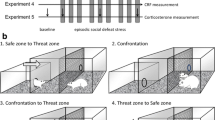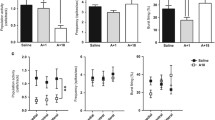Abstract
Normal males participated in sessions providing two operant response options and were administered either diazepam (study I and II) ord-amphetamine (study II). The acute effects of diazepam on human aggressive responding, which ostensibly subtracted points from another person, were determined in study I. Study II was conducted to determine the extent to which social context and response consequence influenced diazepam (study I) andd-amphetamine (previous research) effects on aggressive responding. In study II, the other response option was escape responding which protected the subject's counter from point losses. Aggressive and escape responding were engendered by subtracting points from the subject's counter, and maintained by initiation of intervals free of point loss. Point subtractions were attributed to the other person (study I) or to a machine (study II). Responding to accumulate points exchangeable for money was available in both studies. Acute diazepam administration decreased aggressive responding in most subjects (study I), slightly increased escape responding (study II), and decreased responding to accumulate points. In study II,d-amphetamine increased both escape responding and responding to accumulate points. The effects ofd-amphetamine and diazepam were altered by the instructed source of point loss.
Similar content being viewed by others
References
Avis HH (1974) The neuropharmacology of aggression: a critical review. Psychol Bull 81:47–63
Azcarate CL (1975) Minor tranquilizers in the treatment of aggression. J Nerv Ment Dis 160:100–107
Brown RB (1978) The use of benzodiazepines in prison populations. J Clin Psychiatry 39:219–222
Bruning JL, Kintz BL (1977) Computational handbook of statistics. Second edition. Scott Foresman, Glenview, IL
Buss AH, Durkee A (1957) An inventory for assessing different kinds of hostility. J Consult Psychol 21:343–349
Cherek DR (1981) Effects of smoking different doses of nicotine on human aggressive behavior. Psychopharmacology 75:339–345
Cherek DR, Steinberg JL (1987) Effects of drugs on human aggressive behavior. In: Burrows GD, Werry JS (eds) Advances in human psychopharmacology, Vol IV. JAI Press, Greenwich, CN, pp 239–290
Cherek DR, Steinberg JL, Brauchi JT (1983) Effects of caffeine on human aggressive behavior. Psychiatr Res 8:137–145
Cherek DR, Steinberg JL, Kelly TH, Robinson D (1987) Effects ofd-amphetamine on aggressive responding of normal male subjects. Psychiatr Res 21:257–265
Christmas AJ, Maxwell DR (1970) A comparison of the effects of some benzodiazepines and other drugs on aggressive and exploratory behavior in mice and rats. Neuropharmacology 9:17–29
Cook L, Kelleher RT (1963) Effects of drugs on behavior. Ann Rev Pharmacol 3:205–222
DiMascio A (1973) The effects of benzodiazepines on aggression: reduced or increased? Psychopharmacologia 30:95–102
DiMascio A, Shaker RI, Giller DR (1970) Behavioral toxicity, Part III: Perceptual-cognitive functions and Part IV: emotional (mood) states. In: Shader RI, DiMascio A (eds) Psychotropic drug side effects. Williams & Wilkins, Baltimore, pp 132–141
Eichelman B (1977) Pharmacological management of aggressive disturbances. In: Barchas JD, Berger PA, Ciaranello RD, Elliott GR (eds) Psychopharmacology from theory to practice. Oxford Univ Press, New York, pp 260–269
Emley GS, Hutchinson RR (1983) Unique influences of ten drugs upon post-shock biting attack and pre-shock manual responding. Pharmacol Biochem Behav 19:5–12
Essman WB (1978) Benzodiazepines and aggressive behavior. Mod Probl Pharmacopsychiatry 13:13–28
Feldman PE (1962) An analysis of the efficacy of diazepam. J Neuropsychiatry 3:S62-S67
Goddard P, Lokare VG (1970) Diazepam in the management of epilepsy. Br J Psychiatry 117:213–214
Griffiths RR, Bigelow GE, Liebson I (1983) Differential effects of diazepam and pentobarbital on mood and behavior. Arch Gen Psychiatry 40:865–873
Hall RCW, Zisook S (1981) Paradoxical reactions to benzodiazepines. Br J Clin Pharmacol 11:99S-104S
Hineline PN (1977) Negative reinforcement and avoidance. In: Honig WK, Staddon JER (eds) Handbook of operant behavior. Prentice Hall, Englewood Cliffs, NJ, pp 364–414
Itil TM, Seaman P (1978) Drug treatment of human aggression. Prog Neuro-Psychopharmacol 2:659–669
Johnson GFS (1980) Psychopharmacology of aggression. In: Girgis M, Kiloh LG (eds) Limbic epilepsy and the dyscontrol syndrome. Elsevier, Amsterdam, pp 207–218
Kalina RK (1964) Diazepam: its role in a prison setting. Dis Nerv Sys 25:101–107
Kirk RE (1968) Experimental design: procedures for the behavioral sciences. Brooks/Cole, Belmont, MA
Krsiak M (1979) Effects of drugs on behavior of aggressive mice. Br J Pharmacol 65:525–533
Lindsley OR (1966) Experimental analysis of cooperation and competition. In: Verhave T (ed) The experimental analysis of behavior: selected readings Appleton-Century-Crofts, New York, pp 470–501
Lion JR, Azcarate CL, Koepke HH (1975) “Paradoxical rage reactions” during psychotropic medication. Dis Nerv Sys 36:557–558
McNair DM, Lorr M, Droppleman LF (1971) Profile of mood states-manual. Education and Industrial Testing Service, San Diego, CA
Miczek KA, Krsiak M (1979) Drug effects on agonistic behavior. In: Thompson T, Dews PB (eds) Advances in behavioral pharmacology, Vol 2. Academic Press, New York, pp 87–162
Poshivalov VP (1981) Pharmaco-ethological analysis of social behavior of isolated mice. Pharmacol Biochem Behav 14, Suppl 1:53–59
Randall LO, Heise GA, Schallek W, Bagdon RE, Banziger R, Boris A, Moe RA, Abrams WB (1961) Pharmacological and clinical studies on valium a new psychotherapeutic agent of the benzodiazepine class. Curr Ther Res 3:405–425
Rodgers RJ, Waters AJ (1985) Benzodiazepines and their antagonists: a pharmacoethological analysis with particular reference to effects on “aggression”. Neurosci Biobehav Rev 9:21–35
Sanger DJ, Blackman DE (1981) Rate-dependence and the effects of benzodiazepines. In: Thompson T, Dews PB, McKim WA (eds) Advances in behavioral pharmacology, Vol 3. Academic Press, New York, pp 1–20
Skolnick P, Reed GF, Paul SM (1985) Benzodiazepine-receptor mediated inhibition of isolation-induced aggression in mice. Pharmacol Biochem Behav 23:17–20
Taylor SP (1967) Aggressive behavior and physiological arousal as a function of provocation and the tendency to inhibit aggression. J Person 35:297–310
Tewes PA, Fischman MW (1982) Effects ofd-amphetamine and diazepam on fixed-interval, fixed-ratio responding in humans. J Pharmacol Exp Ther 221:373–383
Thompson T, Boren JJ (1977) Operant behavioral pharmacology. In: Honig WK, Staddon JER (eds) Handbook of operant behavior. Prentice Hall, Englewood Cliffs, NJ, pp 540–569
Valzelli L, Giacalone E, Garattini S (1967) Pharmacological control of aggressive behavior in mice. Eur J Pharmacol 2:144–146
Wilkinson CJ (1985) Effects of diazepam (Valium) and trait anxiety on human physical aggression and emotional state. J Behav Med 8:101–114
Winer BJ (1971) Statistical principles in experimental design. McGraw-Hill, New York
Author information
Authors and Affiliations
Rights and permissions
About this article
Cite this article
Cherek, D.R., Steinberg, J.L., Kelly, T.H. et al. Effects of acute administration of diazepam andd-amphetamine on aggressive and escape responding of normal male subjects. Psychopharmacology 100, 173–181 (1990). https://doi.org/10.1007/BF02244402
Received:
Revised:
Issue Date:
DOI: https://doi.org/10.1007/BF02244402




